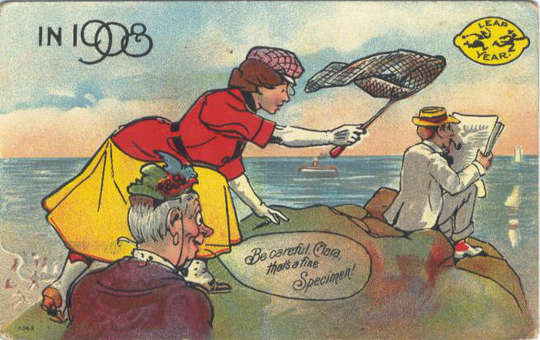PRINT CONNECTIONS
29 Days a-Leaping
Last year (2016) had a leap day, February 29 (because 2016 needed more days, didn’t it?), and while I understand why leap years exist, it’s always bugged me that the extra day is added to February — the one month of the year that we don’t want to make longer, at least here in the Northeast. Why not put it in a summer month, when we can have an extra day of nice weather? Or is this some kind of Southern Hemisphere conspiracy?

If Edgar Allan Poe had worked for the phone company, “A Cask of Amontillado” might have gone something like this. (Photo by Scott Ehardt)
So, what to do with the extra day? I guess I could read the phone book, as I see from the week-old stack in the lobby of my apartment building that the new one is out. Or, at least, a new phone book is out. There was a time, back in the 2000s, when I used to routinely get four or five of them, all with different listings, which made looking for specific people or businesses a bit of a chore. No wonder we all just started Googling for the number we wanted — assuming we even want a number anymore. There are municipalities, like San Francisco, that have tried to ban phone books outright. I wouldn’t go that far, but I do like the idea of an opt-in/out ability. After all, there are still people who use them, if only for a practical joke.
Apparently, it is not unheard of for some merry college prankster to fill his roommate’s room full of torn-out pages from the phone book, or even to brick up someone’s doorway with phone books. It’s something to do with those unwanted stacks of them, I guess.
The idea of the practical joke is probably as old as humanity, but some of the oldest on record were pulled by Roman Emperor Elagabalus (c. 203–222). Born Varius Avitus Bassianus, as emperor he took the name Marcus Aurelius Antoninus Augustus; he was named Elagabalus posthumously after the Syrian sun-god Elagabal, which was essentially a black rock. Elagabalus was a high priest of Elagabal and it was his attempt to replace Jupiter in the Roman pantheon with his name-sake/rock, among other things, that led to his assassination at age 18.
Elagabalus was a bit “out there” even by Roman Emperor standards. Ascending the throne at age 15 (so right there you know there’s gonna be trouble), he was married as many as five times, although he was known to swing both ways. He had a thing for charioteers and tried to appoint several of them to high positions, and his habit of prostituting himself in the palace did not go over well with the Praetorian Guard — or with just about anyone else. In Decline and Fall of the Roman Empire, Gibbon remarked that Elagabalus “abandoned himself to the grossest pleasures and ungoverned fury and soon found disgust and satiety in the midst of his enjoyments” (Gibbon, 1782).
He was also fond of practical jokes. Here’s one laugh riot:
[Elagabalus] would often shut his friends up when they were drunk and suddenly, in the night, let in lions and leopards and bears — rendered harmless — so that when they woke up they would find at dawn, or what is worse, at night, lions, bears and panthers in the same bedroom as themselves. Several of them died as a result of this (Icks, 2012).
Waka waka!
He also invented a sort of whoopee cushion; he would have dinner guests sit on air cushions and then, over the course of the meal, he would have slave boys surreptitiously and slowly let the air out until the diners were under the table — and not because of too much wine. This was when Elagabalus actually served proper food, rather than bits of glass or, on occasion, pictures of food rather than actual food. Fun-ny.
Needless to say, he did not last long as emperor; after a mere three years, members of the Praetorian Guard finally had enough of him, so they killed him, cut off his head, dragged his body around Rome, then dumped it in the Tiber. Now that’s a practical joke!
Practical jokes can be taken to other kinds of extremes, even when they don’t involve large, feral mammals. One of the most famous practical jokes in history, the “Berners Street Hoax,” was perpetrated by Theodore Hook (1788–1841), a British man of letters and inveterate practical joker. He was only 22 at the time, so perhaps he could be excused (or not), but as the story goes, Hook had made a bet with a friend of his that he could make any house in London the most famous address in the city in less than a week. The home, chosen at random (or because Hook and his friend happened to be walking past it at the time the bet was made), was 54 Berners Street, the home of an unwitting Mrs. Tottenham, who had no connection whatsoever to Hook.
On the morning of November 27, 1810, she suddenly found all kinds of tradespeople and deliverymen arriving at her front door with items they had been instructed to deliver: coal, furniture, pianos (several of them), organs (musical, not human, although I wouldn’t put that past Hook), clothing, jewelry, wine, wigs — you name it. The delivery people all claimed they had received letters to deliver the items to that address, which the Tottenham household quite strenuously denied. The letters had been sent by Hook of course, and by mid-day, 54 Berners Street was a mob scene of angry, shouting merchants. And then the Lord Mayor of London showed up, having received a letter requesting his presence at Mrs. Tottenham’s. This is about when the joke jumped the shark, and the Mayor stalked off in a huff, if not a minute and a huff.
There was much media coverage (such as existed in 1810) but at any rate, Hook won his bet: it did become the most famous address in London for a short period.
Hook was well-known for all kinds of japery. However, he also leads into the last chapter of our story because Hook is also regarded as having received the oldest known picture postcard. Sent in 1840, the belief is that Hook mailed it to himself as a practical joke — although that’s pretty weak tea compared to his earlier jokes; I guess he started slipping in his old age. Of course, it may have appealed to Hook because the image is a caricature of postal service workers. This postcard was only found as recently 2001, when it was uncovered in a stamp collection. A year later it sold at auction for £31,750.
There is a lot to be said about postcards and the history thereof, but in the States, the picture postcard didn’t get going in earnest until the 1870s, and by the end of the first decade of the 20th century, the “Golden Age of the American Postcard” had reached its peak (see also here). Indeed, postcards were almost like the text messages of the day — people sent jokes or other short messages back and forth on postcards, helped by the fact that mail delivery was twice a day.
And in 1908, leap year-related postcards were all the rage. Here’s why. Around the turn of the century, there was a tradition or belief — of uncertain origin, perhaps Irish and/or Scottish — that only on leap years was it socially acceptable for women to propose marriage to men, rather than vice versa. (This also inspired Al Capp’s “Sadie Hawkins Day” in L’il Abner when girls are allowed to ask boys out.)
Lest this sound like female empowerment at a time when there was precious little of it, it tended to manifest itself in a slew of humorous picture postcards that depicted overweight harridans and desperate spinsters chasing scrawny men with butterfly nets and the like. Not exactly subtle, but the caricature of the desperate spinster would continue in cartoons, movies, and sitcoms.
Maybe this year I’ll have some leap year postcards of my own made up. Hmm . . . where to find a postcard printer. I know: I’ll consult the phone book. I’ve got enough of ’em.

References:
- L.V. Anderson, “Get a Hustle On — It’s Leap Year,” Slate, February 28, 2012, http://www.slate.com/articles/double_x/doublex/2012/02/leap_year_postcards_from_the_early_20th_century_showing_women_proposing_to_men.html.
- “Oldest postcard sells for £31,750,” BBC, March, 8, 2002, http://news.bbc.co.uk/2/hi/uk_news/1862284.stm.
- Cassius Dio, Roman History, Book LXXX, http://penelope.uchicago.edu/Thayer/E/Roman/Texts/Cassius_Dio/80*.html#79-20.
- Edward Gibbon, The History of the Decline and Fall of the Roman Empire: Volume I, Chapter VI: Death Of Severus, Tyranny Of Caracalla, Usurpation Of Marcinus. — Part III, 1782 (rev. 1845), http://www.gutenberg.org/files/731/731-h/731-h.htm#link6note-56.
- Martjin Icks,__ The Crimes Of Elagabalus: The Life and Legacy of Rome’s Decadent Boy Emperor__, Cambridge, Mass.: Harvard University Press, 2012, via Literary Review, September 2011, http://focreviews.blogspot.com/2011/09/crimes-of-elagabalus-by-martjin-icks.html.
- Elagabal, Livius.org, http://www.livius.org/articles/religion/elagabal/.
- “The Berners Street Hoax,” Museum of Hoaxes, http://hoaxes.org/archive/permalink/the_berners_street_hoax/.
- Julie Winterbottom, “4 of the Oldest Pranks in the Book,” Mental Floss, April 1, 2013, http://mentalfloss.com/article/49682/4-oldest-pranks-book.
- “Elagabalus,” Wikipedia, last modified on January 30, 2016, retrieved February 4, 2016, https://en.wikipedia.org/wiki/Elagabalus.
- “Leap Year,” Wikipedia, last modified on February 4, 2016, retrieved February 4, 2016, https://en.wikipedia.org/wiki/Leap_year.
- “Post card,” Wikipedia, January 28, 2016, retrieved February 4, 2016, https://en.wikipedia.org/wiki/Postcard.
- “Practical Joke,” Wikipedia, last modified on January 31, 2016, retrieved February 4, 2016, https://en.wikipedia.org/wiki/Practical_joke.
- “Theodore Hook,” Wikipedia, last modified on February 3, 2016, retrieved February 4, 2016, https://en.wikipedia.org/wiki/Theodore_Hook.
< My Funny Valentine | Fan Club >
Top ↑